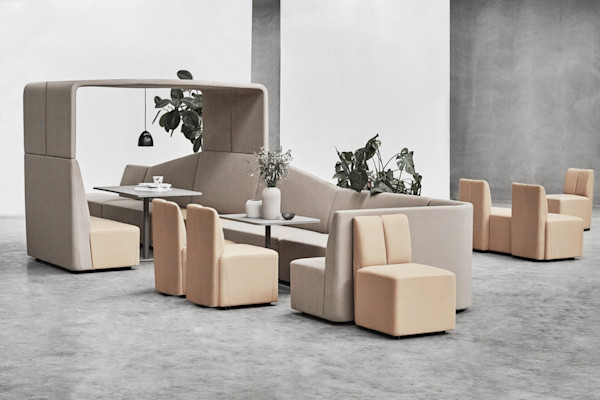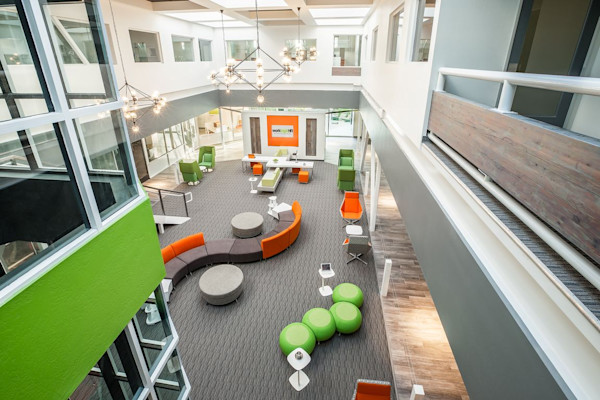A Custom Design for Your Custom Office

Everybody has their own idea of a perfect, custom office. This is usually an office that best fits the needs of the company and its employees. The office is a place where companies can showcase their brand image. It can be an area of expression for employees. Most importantly, it’s a space that gives workers the chance to work to the best of their abilities.
The ideal office can’t be duplicated. There isn’t a roadmap that helps companies build and design exactly what they need. The perfect office starts with an understanding – the knowledge of what the company needs. Without clear design goals and objectives, a company runs the risk of solely creating a space, rather than a key working environment. There are parts of an office that can help employees be more productive, improve job satisfaction, and most importantly, promote employee wellness.
However, the process of designing a custom office can be intimidating. There’s a lot that goes into building exactly what you need. A company might know exactly what they need, but making it a reality might not be as easy. The process doesn’t have to be daunting. Designing a new office should be exciting. It is a turning point for your company and employees. But how does a custom design really make a difference?
Why is a Custom Design Key?

Find custom office design solutions to build the perfect space
From furniture to functionality to brand image, the possibilities are endless when it comes to office design. While there is a lot to consider when building a custom office, it’s key to get it right the first time. Without an office that suits a company and its employees’ needs, fine tuning a workspace can cost a company a lot of time and money in the long run. But how do you ensure your custom office is really custom to you?
An office design should reflect its employees and how they work. Employees need the necessary tools to do their jobs, and tailoring the office to their needs is the best way to give them what they need. From workspace to custom office furniture, almost every part of the office design can be changed to improve productivity, efficiency, and working experience.
Across many industries, the perfect office looks different. Call centers might need modern office cubicles to create privacy and limit distractions. Marketing firms might need large, shared spaces for collaboration. And companies with constantly evolving needs might use a more adaptive design. Although there are office design elements that are unique to industries, the layout, the furniture, and the environment are what should be unique to the company. The uniqueness of a custom design helps you avoid building a generic office – one that doesn’t reflect the company, its image, and its employees. But why exactly should you avoid a generic office design?
The Generic Office

Learn more about custom office furniture for your office
Bland offices lined with stations from wall to wall, open floor plans with rows of rigid desks, and plain rooms with standard water coolers are reminiscent of the generic offices of the past. However, for many, the generic office is a reality and not really a thing of the past. The generic office design that checks all of the basics doesn’t mean that all of the office needs are being met.
A recent piece from Indeed discusses office design and the impact it has on a company’s success. The article shows 16 design tips for optimizing employee production. A custom office design takes into consideration everything from adaptability to distractions to flexibility. From simple elements like biophilics – the incorporation of natural elements in office design – to automation, a successful office is more than choosing the right chairs and desks.
The generic office doesn’t have all the extras that make the job more enjoyable or even easier. A generic office is the bare bones. It’s only a space to work and not a destination. Building a custom office can be difficult. Ensuring employees have what they need, accurately promoting brand image, and building an office that fits the company requires a lot of thought and careful planning. However, that’s where we come in.
Our Custom Design Experience

Build an office that reflects your company’s brand
StrongProject isn’t only an office furniture company. We create an experience from helping you establish and identify your design goals, to finding the furniture that perfectly suits your company’s needs, to the installation process. Also, we realize that choosing custom furniture for your office is just one part of the whole process.
We know that needs to extend beyond the types of desks or finishes. We take into account other key factors. From budgets to space limits, there are often things that are out of our clients’ control and impact what is possible. Taking all of these factors into consideration while building a custom office is key to building a successful office.
To companies, different parts of office design are more key than others. We know that your needs and office are unique to your company. Our design team helps ensure your needs are met. From design consults to CAD drawings, we include added service through the process at no cost to you.
The Custom Process

Learn more about how we help throughout the entire design process
Office design is a process. It isn’t something that happens overnight. Whether this is your first custom design or it’s time for an office redesign, we know the importance of starting the design process early. It takes time to find your needs and the solutions. What pieces of custom furniture do you want to include? How does the design reflect the brand image? Does your office fit the scope of work? These are the things that need careful thought and planning.
If you’re considering building the office of your dreams, let StrongProject help you through the process. Our expert design team will help make your ideas come to life.
Want to learn more about building an office for your employees? Check out these related posts:



